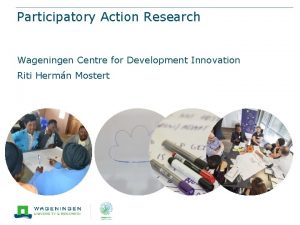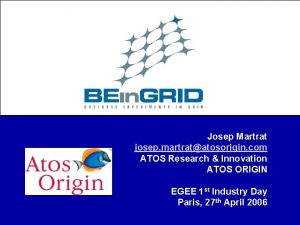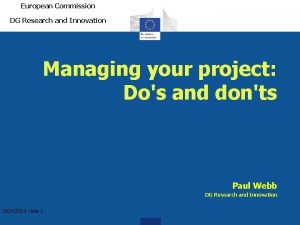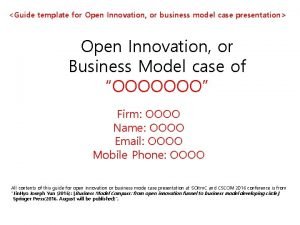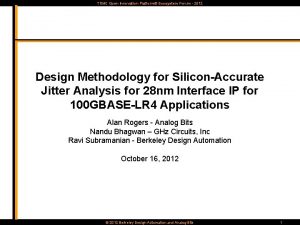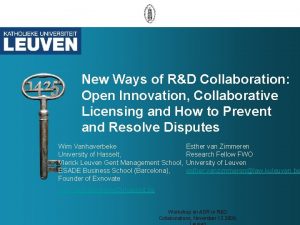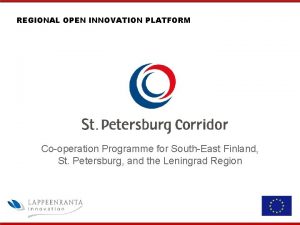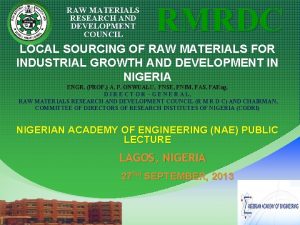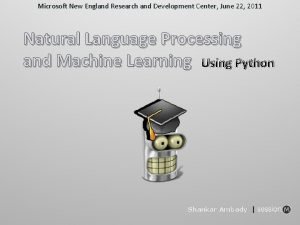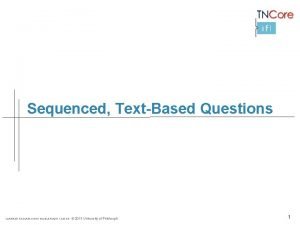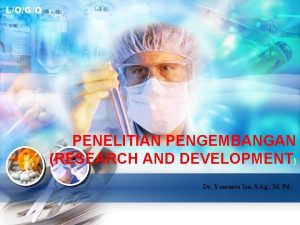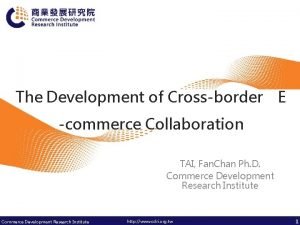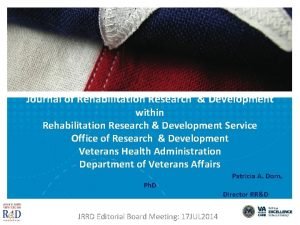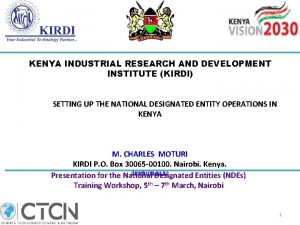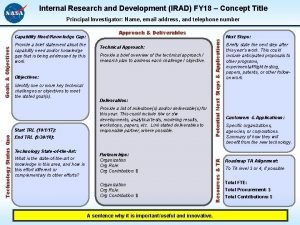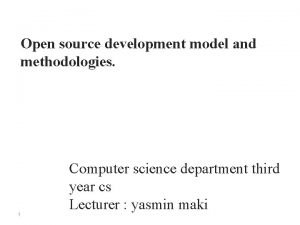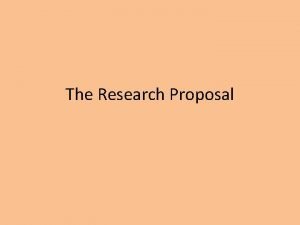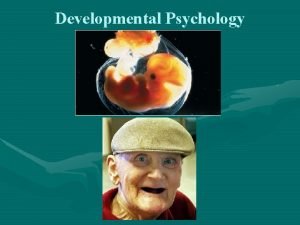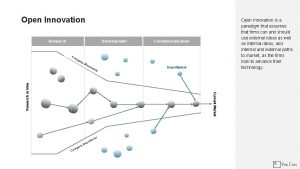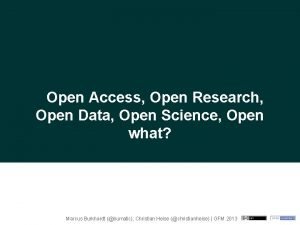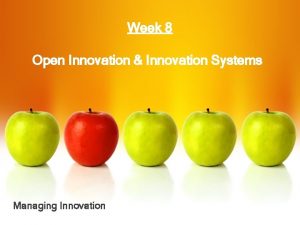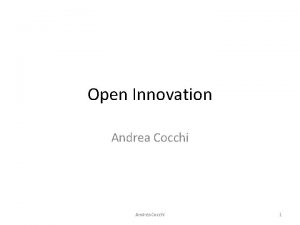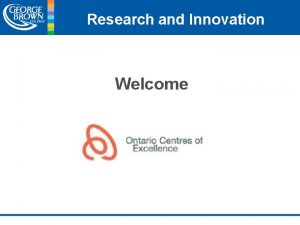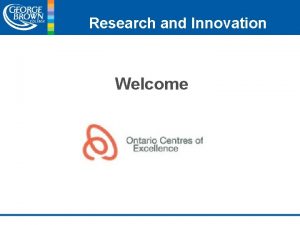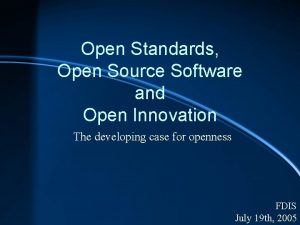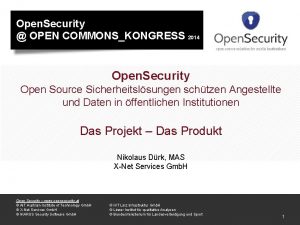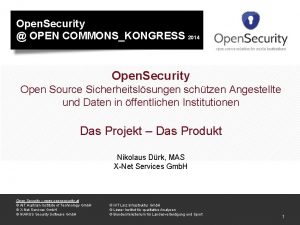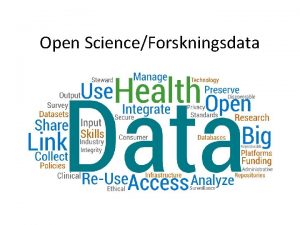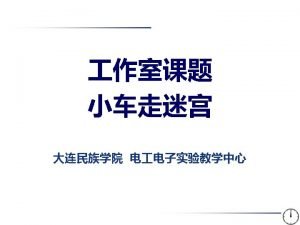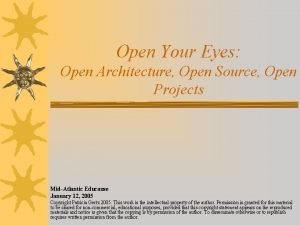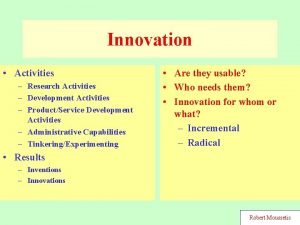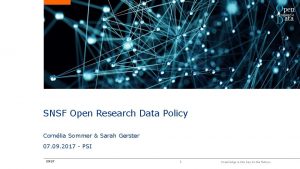Open Innovation Research Development Open Innovation is a











































- Slides: 43

Open Innovation Research Development Open Innovation is a paradigm that assumes that firms can and should use external ideas as well as internal ideas, and internal and external paths to market, as the firms look to advance their technology. Commercialization Co m pa ny Bo un da ri New Market Current Market Research or Idea es Co mp y an Bo u s rie a nd

The balanced scorecard is a strategy performance management tool – a semi-standard structured report, that can be used by managers to keep track of the execution of activities by the staff within their control and to monitor the consequences arising from these actions. Balanced Scorecard Mission, Vision and Strategy Processes Finances Potential Customers Objective Value Variable Initiative

Scenario Technique Global Scenario Fo cu Insights se ce na Create Options Insights Strategic Vision n es Pla iliti sib s o P Competitive Position d. S rio The “scenario technique” is used for strategic planning and future research planning in order to determine future scenarios. After the idea generation process in this technique follows the scenario analysis, which provides an analysis of the different development opportunities within a scenario.

Six Boxes Resources Tools, materials, technology, equipment, improved lighting, adequate project budgets, suppliers, etc. Better healthcare system, more physical exercises, more relaxation time, stress management, better dietary habits, etc. Recognition, performance based pay, bonuses, benefits, job security, prestige of position, chances for advancement, etc. Structure Logical reporting relationships, management support, quality inputs, logical steps to follow, realistic policies, meaningful mission statement, etc. Information Capacity Six Boxes Motives Knowledge Feedback on your performances, clear standards, customer feedback, reliable data, reference materials, etc. Training, job aids, coaching, mentoring, OJT, continuing education, etc. The six-box model is a generic framework developed by the American analyst Marvin Weisbord to assess the functioning of organizations. The sixboxes that make up the model are: Purposes, structure, relationships, rewards, leadership, and helpful mechanisms.

The Core Competence Model focuses on a combination of specific, collaborative, integrated and applied knowledge, skills and attitude. The strategic objectives should not focus on fighting off the competition, but on creating a new competitive space. Core Competence Model 1 2 3 4 5 6 7 Business Area 2 Business Area 1 9 Business Area 3 Core Product 1 Competence 1 8 Core Product 2 Competence 3 Competence 4 10

Internationalization Strategy The Lem, Van Tulder, and Geleynse Model helps companies plan tasks and activities associated with international expansion or conquering new markets. Secondary Motivations Globally Mixed Transnational Regional Local Intrinsic Multi Domestic Widespread Mixed Degree of Coordination Focused Degree of Coordination Trade Strategic Local Primary Motivations Mixed Global Extrinsic Tactical

Strategy Map Satisfied Shareholders Finances Sales Growth Product Guide Customers “Promise me the highest quality” Improve EBITDA Customer Focus Efficient Operation “Always offer fair price” a “Resolve my issues” Improve quality control Improve sales channels Understand customers Reduce losses Sector Communicate Competence Improve Strengthen Corporate Culture Process Development / Knowledge A strategy map supports the company in implementing its strategy. This model is based on the work of Robert S. Kaplan and David P. Norton and is an offshoot of the balanced scorecard.

Bridges Transition Model The Bridges Transition Model is a model that helps a business or person with organizational change. The strength of this model is that it focuses on the transition to change. It's this transition that's often uncomfortable for people, leading to resistance. Neutral Zone New Beginnings Anger Confusion, Excitement Fear Apathy, Motivation Sadness Frustration Energy Productivity during transition Ending Time

7 -S Framework Hard Elements Structure 1 Strategy 6 2 Systems 3 Styles Shared Value Skills 5 Soft Elements 4 Staff The Mc. Kinsey 7 S Framework is a management model developed by business consultants Robert H. Waterman, Jr. and Tom Peters in the 1980 s. This was a strategic vision for groups, to include businesses, business units, and teams. The 7 Ss are structure, strategy, systems, skills, style, staff and shared values.

Capital Asset Pricing Model (CAPM) Expected Return Capital Market Line Ideal Market Portfolio Inferior Portfolio & Individual Assets Risk Free % Efficient Frontier Expected Risk In finance, the capital asset pricing model is a model used to determine a theoretically appropriate required rate of return of an asset, to make decisions about adding assets to a well-diversified portfolio.

Just-In-Time/Lean Thinking Just-in-time production is used to implement effective production to meet demands. Level 1 Current Demand Level 2 Reduce Delays Minimize Errors & Defects Reduce Inventory Minimize Downtime Level 3 Simplicity & Transparency The aim is to achieve sustainable cost reductions for all participants, suppliers, customers, and producers. The just-in-time strategy was developed by Taiichi Ohno for Toyota’s production system.

SWOT analysis is a strategic planning technique used to help a person or organization identify strengths, weaknesses, opportunities, and threats related to business competition or project planning. SWOT Analysis S W O T Strength Weakness Opportunities Threats § Things your company does well § Things your company lacks § Underserved markets for specific § Emerging competitors products § Qualities that separate your competitors from § Things your competitors do § Changing regulatory environment better than you § Few competitors in your area § Negative press/media coverage § Internal resources § Resource limitations § Emerging need for your or services § Tangible assets § Unclear unique selling proposition § Press/media coverage products § Changing customer attitudes

Theory X and Theory Y Management Staff Based on the assumption that employees are generally lazy, refuse to work, and keep their workload as light as possible. Based on the assumption that employees support the organization when given the chance Staff Management Theory X and Theory Y are theories of human work motivation and management. Theory X style managers believe their employees are less intelligent, lazier, and work solely for a sustainable income. Theory Y managers assume employees are internally motivated, enjoy their job, and work to better themselves without a direct reward in return.

Real options theory is a modern theory on how to make decisions regarding investments when the future is uncertain. Real options theory draws parallels between the valuation of the financial options available and the real economy. Real Options Theory N=3 u 3. S 0 N=2 N=1 p S 0 = cost of carrying out option u 2. S 0 p N = future decision 1 -p (u 2+d 3) S 0 u. S 0 p d = negative impact of future decision u = positive effects of future decision 1 -p p = change in effect (u+d 2) S 0 1 -p d. S 0 Time

The managerial grid model is a style leadership model. This model originally identified five different leadership styles based on the concern for people and the concern for production. The optimal leadership style in this model is based on Theory Y. Managerial Grid Main focus on interpersonal relationships • Work atmosphere is friendly • Setting goals is secondary • Slower work tempo Impoverished Management • Least effective management style • Minimum effort to get work done • Not focused on employees or tasks 9 Balance between work performance and employee willingness to compromise. needs with 1. 9 9. 9 Team Management 8 Concern for Employees • 7 6 5 • Optimal management style • Adapts to situation • Common goals for all employees • High employee performance 5. 5 Task Management 4 3 2 LOW Country Club Management HIGH Middle-of-the-road Management 1 1 LOW 9. 1 2 3 4 5 Concern for Production 6 7 8 9 HIGH • Focus is on deliverables • Employees are A commodity • Results oriented

Business Model Canvas is a strategic management and lean startup template for developing new or documenting existing business models. = Infrastructure = Customer Focus = Financial Key Partners Key Activities Value Proposition Customer Relationship Customer Segments • Who are our Key Partners • Who are our Key Suppliers • Which Key activities do partners • Our distribution Channels • Revenue Streams • Customer relationships • Which one are established • How costly are they • How are they integrated with the • For whom are we rest of the business model perform Key Resources Sales & Communication • What Key resource do our • • value proposition require • Our distribution channels • Customer relationships How are we reaching them How are channels integrated Which one work best Which is most cost efficient Cost Structure Revenue Sources • Which key resource are the most expensive • Which key activities are the most expensive • What are the most important costs inherent in our • For what do they currently pay ? • How would they prefer to pay ? • How are they currently paying ? business model creating value • Who are our most valued customers

Business Ecosystem Trade Association Extended Enterprise Standard Bodies Suppliers of my suppliers Labor Union Direct Customer Core Business Investor Product suppliers Regulatory authorities Customers of my customers Other stakeholder Suppliers of suppliers competing organizations The business ecosystem, developed by James F. Moore, is designed to illustrate the relationships between stakeholders’ activities, tasks and competencies within an organization.

Socially Engineered Change illustrates how planned change can be successfully designed through transparent communication and consolidation of all teams and organizations within the company. Socially Engineered Change Result FINDINGS DESIGN PREPARATION TRANSITION Establish guiding principles for the organizational model & change process Create communication & transition plans, check availability of resources Implement change: adapt new working methods Decision making by management in the change process Organizational model Program & Project Teams Operational & IT activities Human resource management Design, development, and control of the management information system Culture, behavior Responsibility of Line Management Action & change plans for the transition Interventions: communication & change SAFEGUARDING Safeguard sustainable change in the organizational culture

Crowdsourcing Process Company Publish project on the crowd platform 1 2 Design Crowd Compare designs from around the world 3 Designers Choose the most suitable design & pay the external designer Crowdsourcing involves outsourcing a company’s internal projects and tasks to external crowd members with different competencies. The word comes from the term outsourcing and was coined by the journalist Jeff Howe.

Ansoff Growth Matrix New The Ansoff Matrix is a strategic planning tool that provides a framework to help executives, senior managers, and marketers devise strategies for future growth. It is named after Russian American Igor Ansoff, an applied mathematician and business manager, who created the concept. Diversification Strategy Markets Market Development Growth Strategies Product development Current Market Penetration Current Products New

Stakeholder Management 1. Power Dormant Stakeholder Urgency 5. 4. Dangerous Dominant Stakeholder management is really the “strategic umbrella” covering a group of tactics aimed at building relationships with important audiences that impact, or are impacted, by your organization's business footprint. = Expectant 7. Definite 3. Demanding Stakeholder 6. Dependent = Definitive 2. = Latent Discretionary Stakeholder Legitimacy

Benchmarking Indicators Company Performance Organization and Management • Management Comparison of company indicators with corresponding characteristics • Responsibilities • Planning and control • Organizational structures Company Specific Characteristics • Product complexity Explanatory Factors • Organizational complexity • Company Size Benchmarking allows you to focus on best practices from your competitors. It allows you to get detailed comparisons between companies. It allows for a partnering of information. Most companies are more than willing to discuss their success.

Learning Style Inventory The learning style inventory model is based on various studies by the American scientist David A. Kolb. It addresses the preference for different learning types and the related learning process as a whole. Feeling Concrete Experience Diverging Accommodation Doing Watching Active Experiment Reflective Observation Converging Assimilating Thinking Abstract Concept

High Flow Theory Anxiety Mihaly Csikszentmihalyi's flow theory describes the emotional state of total immersion and concentration on an activity. Flow Channel Degree of Challenges Boredom Low Increasing Challenges Increasing Skills Low Degree of Skills High

People Capability Maturity Model Level 1 Initial Process Employee Management Evaluate Practices Customize Practices Manage Practices Level 2 Repeatable Competence Management A maturity framework that focuses on continuously improving the management and development of the human assets of an organization. Continually Improved Practices Level 4 Managed Level 3 Defined Team Management Capability Management Level 5 Optimized

Evolutionary Growth of Organizations Large Phase 1 Phase 2 Phase 3 Phase 4 Phase 5 Collaboration Bureaucracy Mason Haire is considered a pioneer of the evolutionary growth of organizations model. It visualizes an organization’s life cycle with a specific focus on expected progress and growth, and the related crisis phases. Coordination Size of Company Bureaucracy = Development Delegation Control Direction = Disturbance Autonomy Creative Small Leadership Young Age of Company Mature

STAR Method Situation What was the initial situation? Result What are your conclusions ? STAR Task What was your personal task? Action How did you proceed ? The STAR method is a structured manner of responding to a behavioralbased interview question by discussing the specific situation, task, action, and result of the situation you are describing. Situation: Describe the situation that you were in or the task that you needed to accomplish.

ADDIE Model A Analyze Needs, Requirements and Task D Design Goals, Activities and Exercise D Develop Prototype, Learning Material and Review I Implement Training, Tools and Observation E Evaluate Awareness, Behavior and Results The ADDIE model is the generic process traditionally used by instructional designers and training developers. The five phases —Analysis, Design, Development, Implementation, and Evaluation—represent a dynamic, flexible guideline for building training and performance support tools.

Scrum is an agile process framework for managing complex knowledge work, with an initial emphasis on software development, although it has been used in other fields and is slowly starting to be explored for other complex work, research and advanced technologies. SCRUM Scrum Master Product Owner 24 Hrs. Sprint 1 -4 Weeks Sprint Review +Sprint Retrospective Product Backlog + Sprint Planning Meeting Sprint Backlog (with team) Finished Work

External Strategic Alignment Model Company Domain IT Domain Corporate Strategy IT-Strategy Organizational Information Systems Infrastructure & Processes Internal Strategic Potential Functional Integration SAM is composed of two main dimensions: strategic fit and functional integration. Strategic fit refers to the concordance between internal and external domains (see figure below). Functional integration refers to two type of integration between business and IT domains.

Net Present Value Mil $ The net present value or net present worth applies to a series of cash flows occurring at different times. The present value of a cash flow depends on the interval of time between now and the cash flow. It also depends on the discount rate. NPV accounts for the time value of money. 600 500 400 300 200 100 0 1 st Year 2 nd Year NPV = 3 rd Year 4 th Year 5 th Year Cash flow (in period n) (1 + Discount rate) i 6 th Years

Five Star Model The Star Model consists of five areas that should be connected and aligned to successfully shape the decisions and behaviors of your organization: Strategy, Structure, Processes, Rewards, and People. Strategy Vision, governance, comparative advantage Employees Structure Hiring, work feedback, and learning Five star model Rewards Align goal with rewards, motivation, promotion Power and authority, information flow, organizational roles. Processes Networks, processes teams, integrative roles, matrix structures

Overhead value analysis (OVA) is a technique used to find opportunities to reduce overhead costs. The model focuses on the reduction and optimisation of indirect activities and services in organisations. Overhead Value Analysis gi ar Technology Development n Outbound Logistics Marketing and Sales Service gi Operations ar Inbound Logistics n Procurement M Primary Activities HR Management M Support Activities Company Infrastructure

KANO Model Customer Satisfaction The Kano model is a theory for product development and customer satisfaction developed in the 1980 s by Professor Noriaki Kano, which classifies customer preferences into five categories. Very Satisfied te bu i r tt e. A m or rf Pe c an Excitement Attribute Low Threshold Attribute High Realized Quality Attribute Very Dissatisfied

SECI Model Implicit Knowledge Dialogue Empathy and shared experiences create tacit knowledge Articulating tacit knowledge converts into explicit knowledge Internalization Combination Practice and review embodies explicit knowledge to become tacit knowledge Reviewing, connecting and systematizing explicit knowledge Team Building Externalization Learning by doing explicit knowledge Linking Explicit Knowledge Socialization The SECI model of knowledge dimensions is a model of knowledge creation that explains how tacit and explicit knowledge are converted into organizational knowledge. The SECI model distinguishes four knowledge dimensions – socialization, externalization, combination, and internalization.

Interpersonal Circumplex The interpersonal circle or interpersonal circumplex is a model for conceptualizing, organizing, and assessing interpersonal behavior, traits, and motives. The interpersonal circumplex is defined by two orthogonal axes: a vertical axis and a horizontal axis. Dominance Competitive Leading Aggressive Helpful Opposed Together Defiant Cooperative Withdrawn Submission Dependent

The buy-grid model is a business model depicting rational organizational decision making. Business marketers use the buygrid model to portray the steps businesses go through in making purchase decisions. The number of steps varies with the buyclass, the type of buying decision. Buy-Grid Model Buy Phase New Tasks Modified Rebuy 1 Identify need Maybe 2 Define need Maybe 3 Specify solution 4 Identify supplier 5 Solicit proposal Maybe 6 Evaluate proposal & select supplier Maybe 7 Specify order routine Maybe 8 Review performance Straight Rebuy

Adaption Innovation Inventory Innovator Early Adopter Early Majority Laggards Willingness To Change Willingness To Improve 55 Adaptive Late Majority 100 145 Innovative Based on a study of people’s problem-solving behavior, the British psychologist M. J. Kirton developed a method of analyzing an individual’s personal preference regarding change. Using the results of a questionnaire, he distinguished between adaptive, risk-averse, and innovative personalities.

SHRM Competency Model Business, Leadership, and Interpersonal Behavioral Competence Outcomes Leadership & Navigation Business Acumen Technical Competence Consultation Ethical Practice Critical Evaluation Relationship Management Global & Cultural Communication HR Knowledge Domain People Organization Workplace Strategics & Performance The SHRM Competency Model identifies what it takes to be a successful HR professional—across the performance continuum; around the globe; and across all career levels, job roles and job functions.

Planned Strategy Rejected Strategy Lead and Learn Act and Think Crafting Strategy Deliberate Strategy Change Henry Mintzberg developed the crafting strategy in 1987 based on his reflections on the emergence of strategies. The crafting strategy model is used as an innovative approach to strategy development. Realized Strategy Emergent Strategy

Senge’s Five Disciplines Continuous Shared Vision System Thinking Learning Improvement Personality Mental Models Team Learning Innovation Peter M. Senge’s five disciplines are designed to transform companies into learning organizations with a focus on the social dimension of corporate management.

Ulrich HR Model • Strategic Planning • Cultural & Image • Staffing • Organizational design • Enablement Future Strategic Focus Change Agent Administrative Manager Employee Advocate • Benefits • HR Information System • Compliance People Process Strategic Partner Daily Operational Focus • Employee Relations • Diversity • Workers Compensation A generation of HR professionals used the 'Ulrich model' as the basis for transforming their HR functions, based on the idea of separating the HR policy making, administration and business partner roles.

DELPHI Method The Delphi method is a forecasting process framework based on the results of multiple rounds of questionnaires sent to a panel of experts. Several rounds of questionnaires are sent out to the group of experts, and the anonymous responses are aggregated and shared with the group after each round. DELPHI Result Interim Result Question/Theories DELPHI Survey/Expert Written Answers Feedback/Demand Feedback
 Open innovation open science open to the world
Open innovation open science open to the world Rdi singapore
Rdi singapore Mysite.socccd
Mysite.socccd Disruptive and radical innovation
Disruptive and radical innovation Action wageningen
Action wageningen Martrat
Martrat Dg research and innovation
Dg research and innovation Open innovation canvas
Open innovation canvas Tsmc open innovation platform
Tsmc open innovation platform Exnovate
Exnovate Open innovation platform
Open innovation platform Purpose of community development
Purpose of community development Development that ended much development crossword
Development that ended much development crossword Two types of pattern development
Two types of pattern development Raw material research and development council
Raw material research and development council Microsoft new england research and development center
Microsoft new england research and development center China aerodynamics research and development center
China aerodynamics research and development center Learning research and development center
Learning research and development center National space research and development agency
National space research and development agency Research and development logo
Research and development logo Educational research and development
Educational research and development Development research centre of the state council
Development research centre of the state council Pfizer worldwide research and development
Pfizer worldwide research and development Commerce development research institute
Commerce development research institute Research and development contracts
Research and development contracts Jrrd journal
Jrrd journal Sunrise agriland development & research pvt. ltd.
Sunrise agriland development & research pvt. ltd. Ohio agricultural research and development center
Ohio agricultural research and development center Kirdi logo
Kirdi logo Irad research and development
Irad research and development National aquatic resources research and development agency
National aquatic resources research and development agency Open source development model
Open source development model Research report vs research proposal
Research report vs research proposal Method vs methodology
Method vs methodology Appendix in research paper
Appendix in research paper Conclusive research advantages and disadvantages
Conclusive research advantages and disadvantages Scope definition in research
Scope definition in research Qualitative research plan
Qualitative research plan Contrast applied research and basic research
Contrast applied research and basic research Identification and formulation of research problem
Identification and formulation of research problem Research instrument in experimental research
Research instrument in experimental research 40 days baby in womb
40 days baby in womb Correlational research
Correlational research What are the components of chapter 3 in research
What are the components of chapter 3 in research




